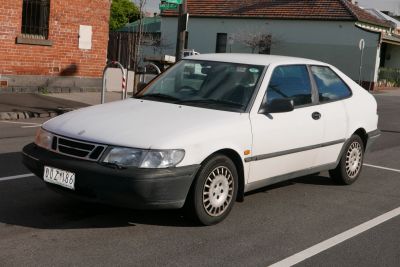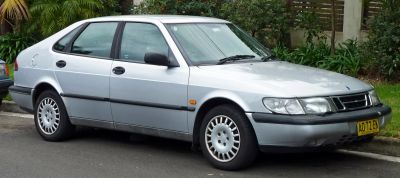 1999 Saab 9-3 I Dimensions, Size & Specs
1999 Saab 9-3 I Dimensions, Size & SpecsMeasurements of the 1999 Saab 9-3 I, engineered for optimal performance and comfort
| Dimensions | |
|---|---|
| Length: | 4629 mm182.2 in15.2 ft |
| Width: | 1711 mm67.4 in5.6 ft |
| Height: | 1428 mm56.2 in4.7 ft |
| Trunk Capacity: | 494 liter17.4 cu ft |
| Trunk Capacity (Max): | 1314 liter46.4 cu ft |
| Weight Specifications | |
| Curb Weight: | 1295-1560 kg2855-3439 lbs |
| Maximal permitted Weight: | 1770-1910 kg3902-4211 lbs |
| Tire Specifications | |
| Rims Sizes: | 15-inch rims:
|
| Tire Sizes: |
|
The Saab 9-3 I hatchback, produced from 1998 to 2002 for model years including 1999, combines compact yet practical dimensions ideal for drivers seeking a blend of style and utility. Measuring 4629 mm (182.2 inches) in length, 1711 mm (67.3 inches) in width, and standing 1428 mm (56.2 inches) tall, the Saab 9-3 I offers a balanced footprint suited to urban and suburban environments while maintaining sufficient interior space.
Weighing between 1295 and 1560 kilograms (2856 to 3440 lbs) in curb weight, depending on specification, this hatchback manages a good balance between agility and stability. Its maximum permissible weight ranges from 1770 to 1910 kilograms (3903 to 4210 lbs), accommodating passengers and cargo comfortably.
The luggage capacity is noteworthy, providing 494 liters (17.4 cubic feet) of storage with the rear seats in place, expanding significantly to 1314 liters (46.4 cubic feet) when the rear seats are folded down – a practical feature for those requiring versatile cargo space.
The Saab 9-3 I features rim sizes from 15 to 17 inches (6J x 15, 15, 16, 17) and tire sizes ranging from 185/65 R15 to 215/45 R17, offering options for performance or comfort tuning.
Overall, the Saab 9-3 I hatchback holds a unique position among compact hatchbacks of its time, merging Scandinavian design with practical dimensions and flexible storage, making it a solid choice for drivers who value both form and function in a vehicle from the late 1990s to early 2000s.
Discover the standout features that make the 1999 Saab 9-3 I a leader in its class
Have a question? Please check our knowledgebase first.
The Saab 9-3 I, produced between 1998 and 2002, has distinct dimensions that place it comfortably in the compact car segment. The vehicle measures 4629 mm (182.2 inches) in length, offering a balanced mix of interior space and manageable external size for urban and highway driving. Its width is 1711 mm (67.3 inches), allowing for a stable road presence without being overly wide for most parking spaces and city streets. The height is 1428 mm (56.2 inches), which contributes to the vehicle's sleek hatchback profile while still providing reasonable headroom inside. These dimensions facilitate a good blend of practicality and aerodynamic styling typical of Saab's design philosophy during this period.
The curb weight of the Saab 9-3 I varies depending on specific model variants and equipment, ranging from 1295 kg (2857 lbs) to 1560 kg (3440 lbs). The curb weight refers to the weight of the car with standard equipment and a full fuel tank but without passengers or cargo. The vehicle's maximum permissible weight, which includes passengers, cargo, and fuel, is between 1770 kg (3903 lbs) and 1910 kg (4211 lbs). This weight range highlights the car's solid build quality and robust structure, with the variation accounting for different trim levels and added optional features that may increase overall mass.
The Saab 9-3 I boasts a practical luggage capacity ideal for everyday use and longer trips. With the rear seats in the upright position, the vehicle offers a generous 494 liters (17.4 cubic feet) of cargo space, which is quite competitive in the compact hatchback category. When more space is needed, folding down the rear seats expands the luggage area substantially to 1314 liters (46.4 cubic feet). This flexibility in cargo space allows the Saab 9-3 I to accommodate larger items or increased luggage volume, making it suitable for family outings, grocery runs, or transporting bulky gear.
The Saab 9-3 I’s dimensions of 4629 mm (182.2 inches) length, 1711 mm (67.3 inches) width, and 1428 mm (56.2 inches) height generally allow it to fit comfortably within a standard residential garage. Most single-car garages have a width around 2400 mm (94.5 inches) and a length of approximately 5400 mm (212.6 inches). Given this, the Saab leaves sufficient space for opening doors and maneuvering inside the garage. However, individual garage sizes may vary, so it's always recommended to measure your garage to confirm fitment, particularly if you have additional storage or vehicle equipment inside.
With a width of 1711 mm (67.3 inches), the Saab 9-3 I is on the narrower side compared to many hatchbacks from the late 1990s and early 2000s, which often range between 1700 mm and 1800 mm (66.9 to 70.9 inches). This moderate width benefits urban driving and parking by making it easier to navigate tighter spaces while still maintaining a stable stance on the road. The slightly narrower profile compared to its competitors contributes to agile handling, a hallmark of Saab's driving dynamics, without sacrificing passenger comfort.
The Saab 9-3 I supports a variety of tire and rim specifications, catering to different models and driver preferences. Common rim sizes include 6J x 15, 15, 16, and 17 inches, providing flexibility between comfort, performance, and aesthetics. Corresponding tire sizes vary from 185/65 R15, 195/60 R15, 205/50 R16 to 215/45 R17, allowing owners to select tires that balance ride quality, handling, and appearance. This range of tire and rim options means the Saab 9-3 I can be tailored to suit daily commuting, spirited driving, or a sportier stance.
While exact interior measurements for legroom and headroom can vary slightly by trim and seating arrangement, the Saab 9-3 I offers a spacious cabin for a compact hatchback. The height of 1428 mm (56.2 inches) contributes to ample headroom for both front and rear passengers, and the relatively long overall length of the car (4629 mm / 182.2 inches) helps provide reasonable legroom, especially for front occupants. The design emphasis on ergonomic comfort, typical of Saab, includes supportive seats and a well-considered cockpit layout, which combines comfort with driver engagement.
The Saab 9-3 I (1998-2002) is an evolution of the original 9-3 launched in the early 1990s, marking improvements in both dimensions and design sophistication. The first generation was generally slightly smaller in length and width, offering less interior space and cargo volume. The newer 9-3 I extended length to 4629 mm (182.2 inches) and width to 1711 mm (67.3 inches), providing more cabin room and storage capacity, reflecting changing market demands for versatility and comfort. Design-wise, the 9-3 I adopted a more aerodynamic and modern aesthetic, along with improved materials and build quality, making it a noticeable step forward from its predecessor in terms of style, safety, and overall refinement.
The Saab 9-3 I carves out a unique niche among compact hatchbacks of the late 1990s due to its blend of higher-than-average length (4629 mm / 182.2 inches) and competitive width (1711 mm / 67.3 inches), which translates into a spacious interior and flexible cargo capacity. Its luggage space of 494 liters (17.4 cu ft) is generous compared to rivals like the Volkswagen Golf Mk4 or Ford Focus of that era, which usually offered slightly less cargo room. The Saab also stands out for its solid build quality and aviation-inspired design cues, offering a blend of comfort, safety, and practicality often associated with larger vehicles, making it a well-rounded option for buyers wanting more from a compact hatchback.
The Saab 9-3 I has a maximum permissible weight between 1770 kg (3903 lbs) and 1910 kg (4211 lbs), depending on the specific model and configuration. This maximum weight (gross vehicle weight rating) includes the vehicle itself, occupants, cargo, fuel, and any additional accessories. The relatively high maximum weight capacity means the 9-3 I can safely carry a full complement of passengers and a substantial amount of luggage or equipment without compromising vehicle stability or performance. It also indicates robust chassis and suspension components capable of handling daily driving demands, making it suitable for families or individuals needing versatile transportation options.
Discover similar sized cars.

| Production: | 1993-1998 |
|---|---|
| Model Year: | 1994 |
| Length: | 4637 mm182.6 in |
| Width: | 1711 mm67.4 in |
| Height: | 1436 mm56.5 in |

| Production: | 1993-1998 |
|---|---|
| Model Year: | 1994 |
| Length: | 4637 mm182.6 in |
| Width: | 1711 mm67.4 in |
| Height: | 1436 mm56.5 in |
